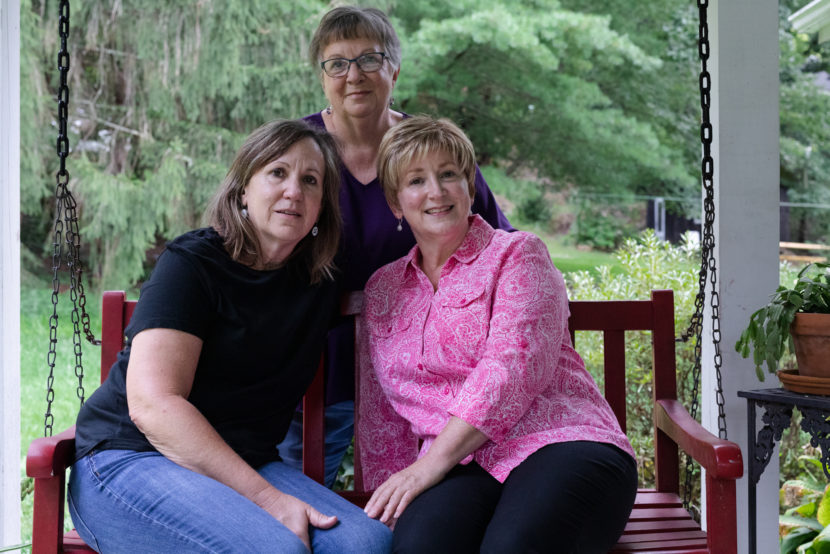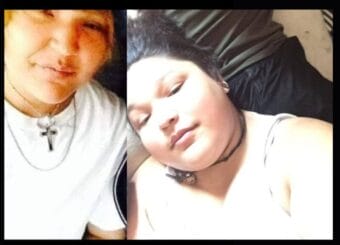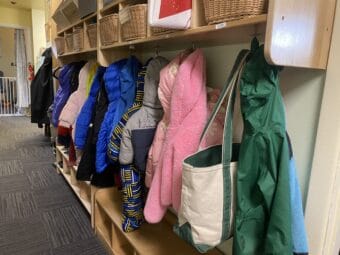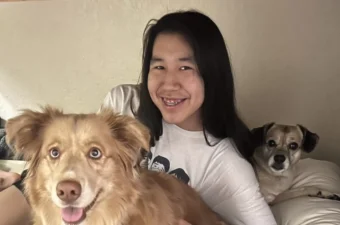
In some families, Alzheimer’s disease seems inevitable.
“Your grandmother has it, your mom has it, your uncle has it, your aunts have it, your cousin has it. I always assumed that I would have it,” says Karen Douthitt, 57.
“It was always in our peripheral vision,” says Karen’s sister June Ward, 61.
“Our own mother started having symptoms at age 62, so it has been a part of our life.”
Nearly a decade ago, Karen, June, and an older sister, Susie Gilliam, 64, set out to learn why Alzheimer’s was affecting so many family members.
Since then, each sister has found out whether she carries a rare gene mutation that makes Alzheimer’s inescapable. And all three have found ways to help scientists trying to develop treatments for the disease.
Bad news on the golf course
I met Karen and June in 2015, at the first-ever conference for families with a particular type of genetic mutation in which Alzheimer’s often appears in middle age.
The annual conference is sponsored by the Alzheimer’s Association and the Dominantly Inherited Alzheimer’s Network Trials Unit, a research program run by Washington University School of Medicine in St. Louis.
Karen and June had come to Washington, D.C., for the family conference because of something they had just learned about a cousin on their mother’s side.
The cousin had developed Alzheimer’s in her 50s. And genetic tests showed that she carried a rare, inherited gene mutation called presenilin 1. It’s one of three mutations that typically cause Alzheimer’s to appear in middle age.
The three gene mutations responsible for early Alzheimer’s are unlike a better known gene called APOE4, which merely increases the likelihood somewhat that a person will develop Alzheimer’s – and usually at age 65 or older. In contrast, the early-onset mutations, including presenilin 1, make it almost certain an individual will develop the disease, and usually before age 60.
Each child of a parent who has the presenilin 1 mutation has a 50% chance of inheriting it.
The genetic finding in Karen’s cousin seemed to explain why the sisters’ mother had developed Alzheimer’s in her early 60s. And it meant that any of the sisters, or all three of them, might also carry the mutation.
Karen got the news in March of 2015, during a round of golf.
Her takeaway: “We now have a coin flip of whether we’ll develop Alzheimer’s by the time we’re 62.” That was “kind of a heavy load on the golf course,” Karen told me at our first meeting.
June had a different reaction: “It was shocking news, but yet there was this element of, ‘oh, so now we finally know what’s been going on.'”
Karen and June talked it over with their older sister Susie.
The sisters had grown up with three other siblings in Swannanoa, a town in the Blue Ridge Mountains of North Carolina. But the three younger girls always had a special bond, “like a three-legged stool,” June says.
So they made a decision together in the spring of 2015.
“We’re doing what we can do,” June told me at the 2015 conference, “which is to participate in the drug trials and try to take what action we can toward a better future.”
They began raising money for the Alzheimer’s Association. And they volunteered for Alzheimer’s drug studies led by researchers at Washington University School of Medicine in St. Louis.
High stakes gene testing
All that happened seven years ago.
This summer, I sat down with Karen and June again. They were attending the annual family conference, this time in San Diego. Susie, the eldest of the three, was there too.
By this time, all three sisters had learned whether they carried the gene mutation.
Karen, the youngest, found out just after the 2015 conference.
“I decided to do gene testing relatively early after that meeting,” she says, “and I’m negative.”
The middle sister, June, waited until March of 2016.
“I decided I was ready to do genetic testing, just cause I like to know things,” she says. “And I turned out to be genetically positive for Alzheimer’s disease, which means that if I live long enough I will get it, unless the [experimental] medicine works.”
For years, Susie had chosen not to find out whether she carried the gene.
“I asked my husband and my two children, and everybody said they’d just as soon not know,” she says.
Eventually, though, their views changed. And in March of this year, Susie discovered that she, like June, carries the gene mutation.
At first, she was devastated.
“The next morning I was wallowing in self pity, and what I’m going to miss,” Susie says. “I’m going to miss birthdays, and my grandchildren won’t know me as a healthy person.
“But then on the front porch, in the mountains of western North Carolina, I’m rocking and there’s this single cloud in a Carolina blue sky, and I was praying for Him to take my worries away. And I’m sitting there rocking and this single cloud thins and thins and thins, and then, poof, it’s gone — and with it my worries.”
A plan for the future
The situation still worries little sister Karen — even though she’s negative for the mutation.
Late last year, she got some alarming news about her own health. She had breast cancer. But Karen says cancer doesn’t make a person feel helpless the way Alzheimer’s does.
“You go see a surgeon. You go see an oncologist. And then you have surgery and then you have radiation or chemo. There’s a to-do list,” she says. “Susie had her diagnosis in March and her to-do list is: Go see an attorney, make a will.”
Karen knows that June and Susie could develop symptoms at any time. She says that will be devastating for her family, which dotes on them.
“We call ’em marshmallows, ’cause they’re so sweet,” she says.
June has found some measure of solace by participating in Alzheimer’s research studies.
She knows the experimental drugs she’s taking are unlikely to help her. But she hopes they’ll eventually lead to treatments that will make a difference to younger members of her family.
“If anything I do can have a positive effect for their lives and their future, I’m all in,” she says.
June also has become a regular at the annual conference for families affected by the early Alzheimer’s mutations. She says it’s a place to hear about scientific advances — and feel a sense of ease.
“There’s a kind of sorrow about Alzheimer’s disease that, as strange as it seems, there’s a comfort in being in the presence of people who understand it,” she says.
June says attending the conference also reminds her that some other families carry a more extreme version of the gene mutation.
“Sometimes I feel guilty because I’m a 61-year-old woman with the gene who can still have a conversation and not make too many faux-pas,” she says. “There are people in their 30s here that are struggling already.”
The three sisters are still hoping for a drug that can slow down Alzheimer’s. But they are also planning for a future without that drug.
Karen and her husband have moved back to her childhood home in the Blue Ridge mountains. They live in the same small house where she and her siblings were raised. It’s part of a family compound they call “the holler.”
“I say it’s like the Kennedy compound except redneck,” Karen says. “Some of the houses have wheels on them. But my dream is to have both of my sisters there.”
“The good thing is we would be surrounded by family and people that have known us since we were children,” June says. “So if we walked away, somebody would help us find our way back home.”
Copyright 2022 NPR. To see more, visit https://www.npr.org.9(MDEwMjQ0ODM1MDEzNDk4MTEzNjU3NTRhYg004))



